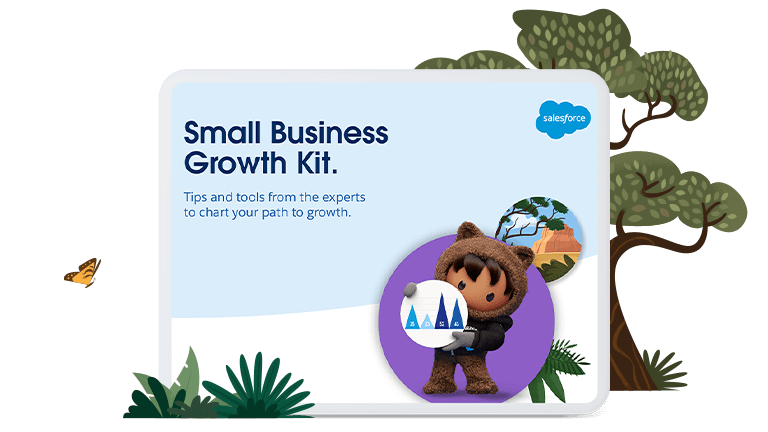Tips and Tools for Creating a Winning Sales Strategy
Sales strategy is changing. Today’s businesses are focused more on the needs of the customer, rather than the hard sell. And with so many companies vying for the customer’s attention, sales pitches need to be more tailored, more relevant and more value-driven than ever before.
The Small Business Growth Kit is now live
View the latest guide for tips on connecting with the customer, mastering your sales pitch, and navigating the twists and turns of the road to business growth.

Luckily, it’s never been easier to reach the customer and deliver exactly what they need, when they need it. And with a range of modern technologies and volumes of data at your disposal, you can even deliver what they didn’t realise they needed – until now.
So get ready to hone your messaging, fire up your CRM and make meaningful connections: Here’s your guide to creating a winning sales strategy.
What is a sales strategy?
A sales strategy is a blueprint for how a business plans to hit its sales goals. By having a sales strategy, businesses can monitor its effectiveness, make adjustments and close more deals.
What to consider when building a sales strategy
When creating a sales strategy, you’ll need to have some basic building blocks in place. These include:
- Your objectives. You can’t build a roadmap if you don’t know where you want to go, so it’s important to set clear goals when creating a sales strategy. You’ll want to consider both short-term and long-term objectives, and set KPIs to measure your progress towards meeting those objectives.
- Your audience. Different prospects will require different strategies, so you’ll want to know your audience well. What channels do they prefer to use? What messaging do they respond to? How can your product or service fit into their lives, and how can you best reach them?
- Your story. Once you know your audience’s story, you’ll need to focus on your business’s story. What’s your competitive differentiator? What can you offer that your competitors can’t? Once you lock in your story, you can put your USP (unique selling proposition) front and centre.
- Your people. Different routes to market will require different roles, so you’ll need to evaluate the people and skillsets in your sales team. Look for any skill gaps in your sales strategy, and see if they can be addressed through digital training platforms. You’ll also want to make sure that you have people who excel at both inbound and outbound sales. Generally speaking, marketing activities drive inbound sales (when a prospective customer contacts your business), while outbound sales are the result of prospecting or cold calling.
- Your process. Your sales process consists of the activities and actions your sales team takes, from generating the lead to closing the deal. The steps that make up your sales process should be repeatable and measurable, so that any weaknesses can be spotted and minimised as you perfect your sales process.
An example of a successful sales process
A successful sales strategy begins with creating an effective sales process. A 7-step plan for forming a sales process might look something like this:
1. Generate leads.
2. Qualify those leads.
3. Highlight your value, tell your story and back it up with data.
4. Consider the objections your prospect might raise and be prepared to address them.
5. Structure the deal so that it’s win/win.
6. Close the deal.
7. Follow up to ensure customer satisfaction and nurture long-term relationships.
6 tips for creating a winning sales strategy
It’s true that there’s no magic wand for creating a successful sales strategy. Strategies will vary based on objectives, skillsets of the team, target market and USP. But the same thing is at the heart of all sales strategies: the customer.
Here are 6 tips for creating a sales strategy to connect with the customer and close more deals.
- Introduce automation to create a tailored marketing programme. If you had to describe today’s marketing in just one word, it would be ‘personalised’. Faceless email blasts now go straight to the Spam folder and one-size-fits-all marketing is as obsolete as dial-up Internet. Even B2B buyers have come to expect an ‘Amazon-like’ experience from businesses, and if you’re not delivering tailored sales experiences at scale, you’re at risk of falling behind your competitors.
- Lead with your customer. We’ve already mentioned that the perfect deal should be structured to be a win/win, and any prospecting calls should lead with the customer’s needs, not the business’s. You only have 8 seconds to grab and hold someone’s attention, so make sure that your opening hook is crafted to create a sense of curiosity. For instance, perhaps you can do a little research before making a prospecting call and identify a unique pain point your competitors haven’t picked up on, which you can solve. You now have the ‘hook’ to lead with when contacting the potential customer.
- Follow the data. Hunches can be great – in fact, some businesses have become legendary for knowing exactly which instincts to follow. But we’re in the information age when data from CRM systems, social media, websites and more can be leveraged to provide robust analytical insights. When looking at customer needs – and how your product or services fit into the modern marketplace – take stock of what the data says.
- Focus on trust and transparency. When we talk about trust, we’re not just referring to building trust in your product or service, but in getting your prospects to trust themselves. For some people, change is risky, even if the downside is minimal and the benefits are large. Stasis seems safe. Keep this in mind when speaking to potential buyers, and establish a relationship of trust and transparency from the outset.
- Turbo-charge your sales teams with new tech. Today’s businesses are more data-driven than ever, and there’s no shortage of technologies that can help you connect with the customer, train and coach your teams, and turn every rep into your best rep. Consider upgrading your technologies to provide your teams with solutions to streamline the sales process and boost productivity, whatever their role may be.
- Make customer satisfaction your top priority. Offering a great customer experience is important for building long-term relationships, especially since expectations for exceptional service have risen dramatically. In fact, the State of Sales report shows that 58% of sales reps say their jobs have changed forever since the start of the pandemic, and customer satisfaction is now the most tracked KPI for sales reps.
Ready to pitch?
If you’ve turbocharged your tools and skilled up the workforce, you’re ready to pitch your product. You’ll want to get some practice in, crafting an elevator pitch that can be delivered in less than 20 seconds, and a longer pitch that can be delivered if you have a captive and curious audience. Your pitch will depend on the person in front of you, so try to be flexible and anticipate the different places the conversation might go.
If you’re a natural extrovert, pitching might be easy for you. If you are more of an introvert, you can still build a winning pitch around your differentiator, which will always be interesting to a client. No matter what sales strategy you choose, we’ll be here to help with a few pointers.
You can check out our pull-out sheet for crafting the perfect pitch in our new toolkit, The SME Growth Kit, and download a free copy of our How to Sell eBook for more selling tips.
The Small Business Growth Kit is now live
View the latest guide for tips on connecting with the customer, mastering your sales pitch, and navigating the twists and turns of the road to business growth.

























